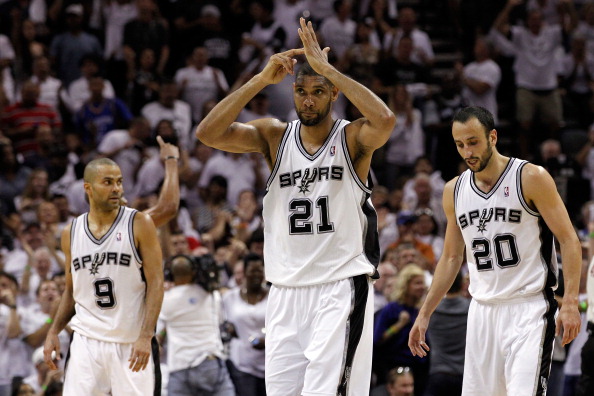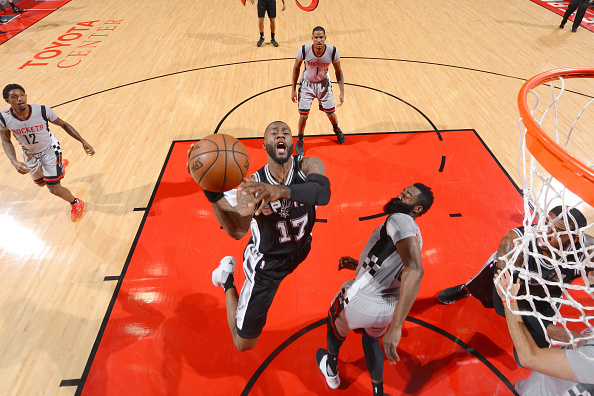
The legend of the San Antonio Spurs and their unknown players

For as long as I’ve been alive, the San Antonio Spurs have been winning. And at the rate they’re going, this will continue for as long as it takes for me to die. The Spurs are one of the best sports teams in American sports, period.
Led by coach Gregg Popovich, this ragtag franchise is the basketball equivalent of a rusty looking, heavily modified Camaro that embarrasses all the Ferraris and the Lamborghinis out front.
As I write this, the San Antonio Spurs have just finished with the Rockets, beating them in six games with Kawhi Leonard watching from the bench. The final score, a 114-75 street-side beatdown of the fast-paced, three-point shooting Houston, tells only half the story because, much like the Spurs themselves, the real beauty is in the details.
A quick lesson in history
The Spurs began as a franchise in 1967 as the Dallas Chaparrals, in what was formerly called the ABA (American Basketball Association), eventually moving across the state to San Antonio, their name an homage to the most Texas commodity available, the cowboy boot, and became the Spurs in 1976.
Even though playoff success eluded them, they enjoyed continual mid-level victories in those years, winning nine division titles between 1976 and Popovich’s arrival in 1988. Post that though, mere division titles would pale in comparison to what they’d do over the next two decades.
Coming into Coach Popovich’s first stint with the Spurs in ’88 (he was an assistant coach at the time), the Spurs had seen their fair share of failure, finishing the previous season with a 21-62 record, the worst in all-time franchise history. These dark clouds did, however, have their silver lining as the Spurs won the first overall pick and with it chose the future face of their franchise, aptly nicknamed “The Admiral”, David Robinson.
A Naval Academy player, he completely turned the Spurs around in his rookie season, as the team finished with a 56-26 record, while he averaged an unfathomable 24 points and 12 rebounds in his first year. The Spurs became a perennial playoff team but enjoyed very little success in the postseason - never moving past the second round.
After suffering at the hands of the Rockets and the Bulls in the 90s, the Spurs saw the dark clouds loom again when Robinson broke his foot in the 1996-97 season which led the Spurs crashing to a 20-62 record.
That meant major changes were on the way and the organisation parted ways with Head Coach Bob Hill, replacing him with their veteran coach Popovich. The losses also paved the way for the Spurs to win the first overall pick again and this time they chose just as wisely, picking the now-first Ballot Hall of Famer Tim Duncan.
This would be the last time San Antonio would be awarded such a high pick, they’d never fail again in the league for the next 20+ years, making the playoffs ever year, winning five championships with the player-coach duo of Duncan and Popovich.
The OG Big Three
Today, the Spurs are renowned for their foresight with respect to player acquisition and development. This is especially impressive considering the fact that due to the continued success of the team, San Antonio and Popovich never won high draft picks and found themselves searching the bottom of the barrel for fresh talent to keep the team going.
In fact, a commonly passed around note amongst General Managers of other teams goes along the lines of, “If the San Antonio Spurs come after one of your players, you’re using him wrong.” Their drafting skills were equally admirable. The Spurs were so good at finding overlooked players and developing them into full-blown stars, that not once, not twice, but three times have they found future Hall of Famers in the shape of late round picks.

The first example came in 1999, when with the 57th pick of the draft, in what is considered one of the greatest draft steals of all time, the Spurs selected never-heard-of Argentine, Manu Ginobili. Manu’s first season playing for the Spurs, however, came two years later, coincidentally along with the final piece of their decade and a half long core, Tony Parker, the undersized, French point guard who was the second last pick of the 2001 draft.
This core of Parker, Ginobili and Duncan would lead the Spurs to four Championships, the first of which came in the first year they played together as they defeated the Suns, Lakers, Mavericks and finally the Nets to seal the title.
Coaching legacy
It isn’t, however, only players where the Spurs have been ahead of the curve. Popovich is also one of the most successful coaches of all time, currently tied with Phil Jackson for a record 20 consecutive winning seasons. He is also one of the longest tenured coaches in the NBA (in his 20 odd years with the Spurs, Coach Pop has lived through 221 Head Coach changes in other teams).
This is no doubt helped by the success the Spurs have enjoyed under him – his career winning percentage is more than 70% through 1700 games (His 1,150+ wins in the regular season are an NBA record for a Head Coach). This success is not simply down to personnel, but speaks about the culture and the work ethic that is imbibed in all Spurs players and staff - “The team always comes before the individual,” no doubt derivative of Coach Pop’s Air Force upbringing (He even considered a career with the CIA at one point).
It should come as no surprise then, that so many current Head Coaches and GMs were at some point assistants or players under Popovich, learning from him before applying these lessons and principles in other teams. Some of the notable products to have come from the Spurs family are -
Name | Position | Team | Experience with SAS |
|---|---|---|---|
Mike Budenholzer | Head Coach and President | Atlanta Hawks | Assistant Coach from ‘96-‘13 |
Steve Kerr | Head Coach | Golden State Warriors | Player (’98-‘01) and Coach (’02-’03) |
Mike D’Antoni | Head Coach | Houston Rockets | (Scout ’99 to ’01) |
Alvin Gentry | Head Coach | New Orleans Pelicans | Assistant Coach (’99-’00) |
Brett Brown | Head Coach | Philadelphia 76’ers | Assistant Coach (’02-’13) |
Earl Watson | Head Coach | Phoenix Suns | Assistant Coach of Austin Spurs, San Antonio’s D-League Affiliate (’14-’15) |
Quin Snyder | Head Coach | Utah Jazz | Coach of Austin Spurs, San Antonio’s D-League Affiliate (’14-’15) |
Mike Brown | Ex- Head Coach | Cleveland Cavaliers | Assistant Coach from (2000-’03) |
Joe Prunty | Assistant Coach | Milwaukee Bucks | Assistant Coach (‘96-’05) |
Scott Layden | General Manager | Minnesota Timberwolves | Assistant GM (’12 to ’16) |
Sam Presti | General Manager | Oklahoma City Thunder | Assistant GM (’05 to ’07) |
Rob Hennigan | General Manager | Orlando Magic | Basketball Operation Assistant (’04-’07) |
Dennis Lindsey | General Manager | Utah Jazz | Assistant GM (’07-’12) |
That’s one-third of all current teams in the NBA who have a high-level front office employee that has come from directly under the San Antonio Spurs and Popovich. It isn’t an over exaggeration, therefore, to say that there has likely been no other individual who has had as much or more of an influence on the modern NBA than Coach Pop.
The new guns
The 2011 draft is considered one of the best in recent memory, producing superstar players like Kyrie Irving, Kemba Walker, Klay Thompson, Jimmy Butler and Isaiah Thomas along with a flood of starter-level talent. The best player from that draft year though is undoubtedly current Spurs captain, Kawhi Leonard, who at the tender age of 25 has established himself as arguably the league’s best two-way player.
Kawhi wasn’t picked by the Spurs, they traded for him on the account of his physical potential, offloading their beloved guard George Hill to the Pacers in exchange for Leonard. Kawhi was drafted with the 15th overall pick, well below his worth as he was considered by scouts to be more of a raw talent without a working jump shot. It is a testament to the Spurs’ player development skills that Kawhi soon became an effective role player, first providing valuable minutes off the bench and then starting for the Spurs as a Small Forward.
Leonard finished the 2013-14 season averaging 13 points, 6 rebounds, 2 assists and 1.7 steals per game as the Spurs clinched a 62-20 record. The playoffs of the same year are when Kawhi stepped into the limelight and proved his worth, the 22-year-old was tasked with the daunting challenge of stopping MVP LeBron James in the Finals.

Not only did he shut down James, he also scored 29 points in the key Game 3 of the series, as the Spurs defeated the Heat 4-1 and won the championship. At 22 years and 351 days, Kawhi became the third youngest player to win Finals MVP, cementing his legacy as the future face of the Spurs.
As of writing this, Leonard is a 2-time All Star, 2-time Defensive Player of the Year, 2-time Defensive First Team and was the NBA Steals Leader in 2015.
Pulling out their end of draft miracles again, the Spurs drafted and trained yet another potential star, the 6’5'' Point Guard Dejounte Murray, 29th pick of the 2016 draft. Murray scored 24 points against the Denver Nuggets, breaking Tony Parker’s record for the youngest Spur in franchise history to score 24 points.
With Tony Parker’s injury in the Playoffs, Murray will start in place of him, along with fellow jewel and 55th pick of the 2009 draft, Patty Mills. It would seem impossible at this point for the Spurs to acquire even one more such player with such calibre, but somehow, they’ve managed to acquire two.
The breakout players of the 2017 Spurs have been Center Dewayne Dedmon and Shooting Guard Jonathon Simmons. Proving their ability to scout and train once again, the Spurs went even further than just the draft to find these players, since both Dedmon and Simmons weren’t actually drafted.
After being undrafted in 2012 and 2013 respectively, Simmons and Dedmon were passed over by multiple teams both in the NBA and the Development League. The Spurs found these two jewels and signed them, getting them to provide minutes off the bench this year.
Had the Rockets-Spurs series been the Finals, Simmons would undoubtedly be the Finals MVP, courtesy of his airtight defence on James Harden in the pivotal Game 6, when Kawhi was on the bench due to an ankle injury.

Simmons spent his initial years with the Spurs D-League affiliate, the Austin Spurs, where he paid the Spurs $150 to work out for them. Two seasons down the line, Simmons held Harden to 10 points on 2/11 shooting, forced 6 turnovers and got Harden to foul out of the game while putting up 18 points on 67% shooting. Murray joined in with his fellow rookie, putting up 11 points, 10 rebounds and 5 assists in 25 minutes.
That’s a Point Guard (Dejounte Murray), a Shooting Guard (Jonathan Simmons), a Small Forward (Kawhi Leonard) and a Center (Dewayne Dedmon), 80% of what could likely be the Spurs starting 5 down the line, consisting of players we’ve never heard of, coming both literally and metaphorically, from places we’ve never seen.